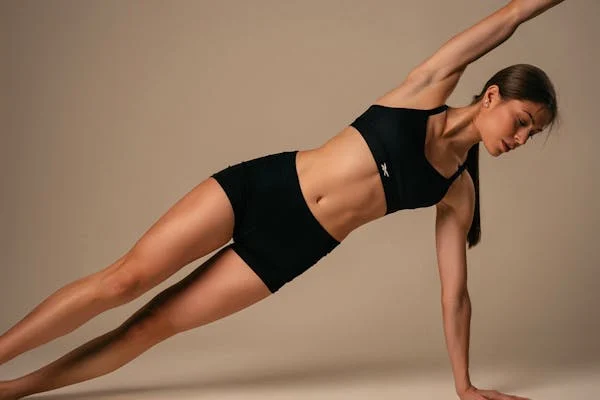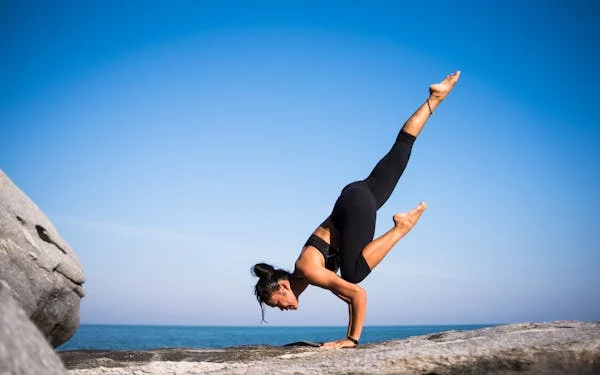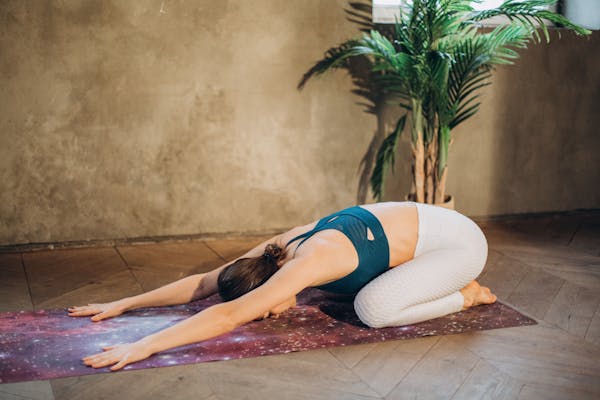Table of Contents
What Are Forward Bending Yoga Asanas?
Forward bending yoga asanas are postures where the body bends forward at the hips, thus creating a deep stretch in the hamstrings, back, and shoulders.
Such poses require flexibility, strength, and mindful breathing. The success of a forward bend asana depends on maintaining proper alignment and engaging your core muscles.
Definition of Forward Bending Yoga Asanas: Forward bends are a category of asanas in which the body bends into a fold from the hips. This action stretches the spine and the muscles of the lower back, hamstrings, and hips.
Common Forward Bending Poses: Some of the most common forward bend asanas include Paschimottanasana (Seated Forward Bend), Uttanasana (Standing Forward Bend), Janu Sirsasana (Head-to-Knee Forward Bend), and Forward Fold (Prone).
Importance in Yoga: Forward bending yoga asanas are essential in enhancing flexibility, relieving tension, and encouraging deep breathing. These poses are usually incorporated in both warming-up and cooling-down sequences.

Physical Benefits of Forward Bending Yoga Asanas
Forward bending yoga asanas provide various physical benefits. By incorporating these poses into your practice, you can significantly improve your flexibility, muscle tone, and joint mobility.
Improved Flexibility
The benefits of forward bends include the flexibility of stretching hamstrings. It is a stretch that gradually can lengthen hamstrings and bring flexibility in legs.
Open up the Hips: Janu Sirsasana also opens up the hip joints and brings flexibility to them by releasing all the tightness in the hip flexors.
Extends the Spine: Forward bending yoga asanas gently stretch and extend the spine so that your posture improves and chances of returning back pain will be reduced.
Strengthens Core and Lower Back
Activates Core Muscles: Most forward bending poses work out the core muscles, just like Paschimottanasana and Uttanasana. By activating them while stretching, numerous benefits are achieved.
Relieves Lower Back Tension: Forward bends can be a great way to release tension in the lower back and alleviate discomfort caused by sitting or standing for long periods.
Stimulates Digestive Health
Massage of Internal Organs: Forward bending poses gently massage the digestive organs, promoting the flow of energy to the abdominal region. This can aid digestion and improve metabolism.
Alleviates Constipation: As these asanas increase the circulation in the abdomen, it stimulates peristalsis- wave-like movements of the intestines that could help alleviate constipation and help in better bowel movement.
Mental and Emotional Benefits of Forward Bending Poses
In addition to the physical benefits, forward bending yoga asanas offer profound mental and emotional benefits. These poses are known for their calming and grounding effects that help reduce stress and anxiety.
Reduces Stress and Anxiety
Calms the Nervous System: Forward bending postures calm the nervous system. They stimulate the parasympathetic nervous system, thus reducing stress and promoting a sense of calmness.
Relaxes Tension: Folding forward will help to loosen tension in the body, particularly in the shoulders, neck, and back. This loosening can help alleviate emotional tension and make you feel more relaxed.
They are led by mindful awareness and presence. These asanas involving forward bending demand focus on the breath and correct alignments. Such mindfulness holds the mind and body anchored to the present, thereby reducing mental chatter and creating a stronger body awareness.
Facilitates Emotional Unblocking: The forward bends have the potential of facilitating emotional unblocking because it opens up the heart and chest area. In fact, several practitioners feel an emotional release coupled with a balanced feeling when one holds the asana for quite some time.


Advantages of Forward Bending Asanas on the Spine
Forward bends contribute largely to keeping one’s spinal cord healthy. As a matter of routine, if one regularly engages in such bends, the person is keeping their spine soft and straight for healthy well-being.
Spinal lengthening is possible by bending forward; thereby one will achieve enhanced flexibility, keeping it loose in an erect position to prevent hunching forward.
Relieves Back Pain: The mild stretch and elongation of the spine help relieve the tension in the back. This is particularly helpful for those who have chronic back pain or tightness.
Improves Posture
Realigns the Spine: Forward bending asanas help realign the spine by encouraging it to lengthen, which counters the effects of poor posture.
Strengthens Postural Muscles: With these asanas, you will strengthen the postural muscles of the spine that are necessary for maintaining upright posture throughout your day.
Forward Bend Asanas to Practice for Flexibility
Here are some of the most effective forward bending yoga asanas that you can incorporate into your routine to enhance flexibility and rejuvenate your body:
Uttanasana (Standing Forward Bend)
Description: A traditional standing forward bend, Uttanasana stretches the hamstrings, calves, and lower back, and calms the mind.
Benefits: Increase flexibility in the legs, opens the hips, and relaxes tension in the spine. It also reinforces a feeling of being grounded in relaxation.
Paschimottanasana – Seated Forward Bend
Description: One of the most recognized forward bends, Paschimottanasana is a seated pose that stretches the hamstrings, calves, and lower back while lengthening the spine.
Benefits: It calms the mind, stretches the back and legs, and improves digestion by stimulating the abdominal organs.
Janu Sirsasana (Head-to-Knee Forward Bend)
Description: This forward bend is focused on stretching one leg at a time while sitting. It targets the hamstrings, hips, and lower back.
Benefits: Opens the hips, stretches the hamstrings, and increases flexibility in the spine.
Prasarita Padottanasana (Wide-Legged Forward Bend)
Description: This wide stance forward bend stretches the inner thighs, hamstrings, and back.
Benefits: Improves flexibility in the legs and spine, helps release tension from the back, and opens the hips.
Baddha Konasana (Bound Angle Pose)
Description: Seated forward bend, which is a good beginners’ forward bend. It concentrates on opening up the hips, stretching the lower back.
Benefits: Increases hip flexibility, strengthens the back, and promotes deep relaxation.


How to Practice Forward Bending Yoga Asanas Safely
While forward bending yoga asanas offer a multitude of benefits, it is crucial to practice them safely in order to avoid injury. Here are some tips on how to practice these poses with proper form:
Engage Your Core
Importance of Core Strength: Engaging the core muscles is important while performing forward bending asanas. It helps protect the lower back and promotes proper alignment.
Proper Alignment
Straight Spine: Try to maintain a straight spine as you bend forward. Don’t over arch your back. This will place unnecessary strain on the spine.
Hinge at the Hips: Focus on hinging forward from the hips, not the waist. This helps to maintain the natural curve of your spine while deepening the stretch.
Go Slow and Listen to Your Body
Don’t Force the Stretch: Forward bending asanas can feel intense, but it’s important not to force the body into the pose. Go as deep as your body allows, and respect your limits.
Use Props: If you can’t reach the floor or feel tight in a pose, consider using blocks or cushions to support your hands or feet. This will allow you to maintain proper alignment and avoid over-stretching.
Common Mistakes to Avoid in Forward Bending Poses
It is easy to make some common mistakes while performing forward bend asanas. Those can be particularly bad in respect of ensuring the maximum benefit from the pose.
Rounding the back is a common mistake. There is a tendency to curve the back and, as a consequence, burden the lower back and neck. To avoid this, keep the spine long and straight.
Locking the Knees: Locking or hyperextending the knees in forward bends can stress the joints. Keep a slight bend in the knees to guard the ligaments.
Holding the Breath: Many practitioners tend to hold their breath when deep in a stretch, but this is essential in maintaining a steady and mindful breath to allow for the stretch and deepen the pose.
Adding Forward Bending Poses to Your Yoga Practice
Forward bending yoga asanas can be included in any part of your yoga sequence, whether you are warming up, cooling down, or working on flexibility:
In Your Warm-up
Start with more gentle forward bends to warm up your body for deeper stretches. Good options include Baddha Konasana and Prasarita Padottanasana.
During the Main Sequence
Include more challenging forward bends such as Paschimottanasana or Janu Sirsasana as part of your standing or seated poses.
As part of a Cool-down Routine
Complete your practice with the deep forward bending postures, including Uttanasana, in order to unwind the psyche and calm the mind.


Conclusion
Incorporating forward bending yoga asanas into your practice is a powerful way to unlock deep flexibility, rejuvenate your body, and cultivate mindfulness.
These poses provide a range of physical, mental, and emotional benefits that can enhance your overall well-being.
Whether you’re aiming to increase flexibility, relieve stress, or improve spinal health, forward bends offer a great way to deepen your practice and experience transformative results.
Remember that it takes some consistency, so start slow, practice mindfully, and enjoy the benefits of forward bending yoga asanas on your way to a more flexible and balanced body and mind.
